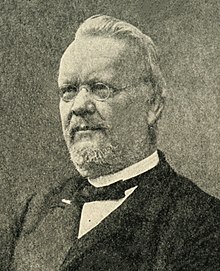Rudolph Leuckart
| Rudolf Leuckart | |
|---|---|

Rudolf Leuckart
|
|
| Born | 7 October 1822 Helmstedt |
| Died | 6 February 1898 (aged 75) Leipzig |
| Citizenship | Germany |
| Fields |
zoology parasitology |
| Institutions |
University of Giessen University of Leipzig |
| Alma mater | University of Göttingen |
| Doctoral advisor | Rudolph Wagner |
| Notable students |
Otto Bütschli Hugo Münsterberg |
| Known for |
Taenia saginata Taenia solium |
Karl Georg Friedrich Rudolf Leuckart (7 October 1822 – 22 February 1898) was a German zoologist born in Helmstedt. He was a nephew to naturalist Friedrich Sigismund Leuckart (1794-1843).
He earned his degree from the University of Göttingen, where he was a student of Rudolf Wagner (1805-1864). Afterwards he participated on a scientific expedition to the North Sea for the study marine invertebrates. Later he became a professor of zoology at the University of Giessen (1850) and the University of Leipzig (1869).
Leuckart is remembered for his work in parasitology, particularly research regarding tapeworm and trichinosis. He was the first to prove that Taenia saginata occurs only in cattle (and humans), and Taenia solium occurs only in swine (and humans). His study of Trichina helped support Rudolf Virchow's campaign to create meat inspection laws in Germany. With Virchow and Friedrich Albert von Zenker (1825-1898), he was the first to document the life cycle of the parasite Trichinella spiralis in swine and humans. He also did important studies of the sheep liver fluke.
Today the "Rudolf-Leuckart-Medaille" is an annual award given for research in parasitology by the Deutschen Gesellschaft für Parasitologie (German Society of Parasitology).
...
Wikipedia
